Full window version (looks a little nicer). Click <Back>
button to get back to small framed version with content indexes.
This material (including line-art images and animations) is copyrighted!
See my copyright
notice for fair use practices.
Another probe of the Sun's interior uses the pulsating motions of the Sun.
The pulsations are too small to be seen just by looking at the Sun. But the
pulsations can be seen if the doppler shifts are measured across the face of the
Sun. Some parts of the Sun expand towards the Earth and adjacent regions
contract away from the Earth. These regions are several thousands of kilometers
across and the pulsation periods are just a few minutes long. Different types of
oscillating waves combine to produce the complicated patterns of pulsation seen.
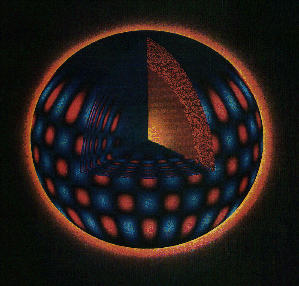
One type of
pulsation is shown here. The blue regions are approaching and the red regions
are receding from you. The pulsations are thought to extend far into the Sun's
interior (courtesy of the National Solar Observatory).
If you disentangle the different oscillation modes from each other, you can
use these waves to probe the solar interior. How those waves propogate through
the Sun and interact with each other depends on the temperature, density, and
composition of the material they pass through. By observing the effects of these
waves on the photosphere of the Sun, you can determine the temperature, density,
and composition of the different layers inside the Sun. Geologists on the Earth
use similar techniques to study the interior of our planet from earthquake waves
in the research field called seismology.
Modifying the name for solar studies, the study of the Sun's interior using the
solar oscillations is called helioseismology.
Solar astronomers have set up a global network of stations to continuously
monitor the Sun's pulsations. This network is called the Global Oscillations
Network Group (GONG). Links to web sites describing GONG and other
helioseismology sites are given below. Instruments to detect solar oscillations
have also been placed on satellites. Check the links below for more information
about them.
- The GONG homepage at the National
Optical Astronomy Observatories is a must see. A concise fact sheet for
GONG is available, as well as, information about helioseismology in general.
- The Solar Oscillations
Investigation at Stanford is another major center for helioseismology
research.
- The Stanford group have also constructed an excellent resourse site for
K-12 students called The Solar
Center. Many educational activities are available, along with excellent
images, movies, and audio (yes, you can hear the Sun pulsate!---the doppler
observations have been converted into sound).
- The Marshall Space
Flight Center's Solar Physics web site is an excellent starting point for
all the research about the Sun. Links to the space missions and the science
background about the Sun are given here.
Vocabulary
| helioseismology |
luminosity |
neutrino |
| nuclear fusion |
proton-proton chain |
solar neutrino problem |
- How does nuclear fusion produce energy?
- Why does nuclear fusion need high temperatures and densities?
- Why is it so hard to develop nuclear fusion as a dependable power source
on Earth?
- Why will chemical reactions or gravitational contraction not work for
powering the Sun?
- What is the net result of the nuclear fusion chain process? Why does
nature use the complicated chain process instead of a one-step fusion
procedure?
- Where are neutrinos produced? What information can they tell you
about interior conditions in the Sun?
- What is the solar neutrino problem? What could be possible
solutions to it?
- How can you use pulsations of the Sun to find out about the structure and
composition of its interior?
Observations of the stars in
all regions of the electromagnetic spectrum and careful observations of the
Sun's pulsation modes and neutrinos provide the data needed to construct models
of the interiors of stars. This section is about how to find out what the
interior of a star is like without physically taking one apart (a rather
difficult thing to do).
Astronomers construct
mathematical models of the interior of a star using the information
pouring from the surfaces of stars (especially the Sun) and their knowledge of
how gases behave under different conditions. The mathematical models are
a set of equations that describe how things work layer by layer in a star.
Fortunately, the interior of stars is completely gaseous all the way to the
center, so the equations are relatively simple (whew!). The physics of gases can
be described with just three parameters:
- Temperature---a measure of the random motion
energy (the average kinetic energy) of the gas particles. The higher
the temperature, the more random kinetic energy is present.
- Pressure---the amount of force/area. Hot gas
expands to create pressure on its surroundings. For example, the gas inside a
hot air balloon pushes out on the material of the balloon enclosing the gas.
- Mass Density---the amount of mass/volume.
Gaseous material can be compressed to smaller volumes and higher densities.
How the three parameters work
together to describe the material you are studying is determined by the
equation of state of the material. This is an equation that relates
density, pressure, and temperature. The equation of state for solids and liquids
is very complex and uncertain. The equation of state for the gas is simple: the
pressure = (a constant × the mass density × the temperature) / (the
molecular weight of the gas). The molecular weight of a
particular type of gas is the combined mass of all of the isotopes of that type
of gas in the proportions found in nature. For hydrogen, the molecular weight is
very close to 1; for helium, the molecular weight is very close to 4. For a gas
made of different types of atoms (such as that found in stars), the molecular
weight is the weighted mean of the different atomic types, taking into account
the relative proportions of the different types of atoms. This equation of state
for simple gases is also called the ideal gas law.
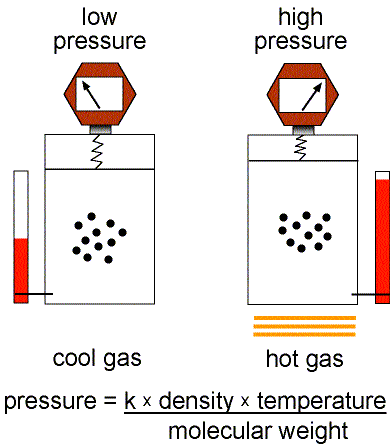 Stars are held together
by gravity. Gravity tries to compress everything to the center. What holds an
ordinary star up and prevents total collapse is thermal and radiation pressure.
The thermal and radiation pressure tries to expand the star layers outward to
infinity.
Stars are held together
by gravity. Gravity tries to compress everything to the center. What holds an
ordinary star up and prevents total collapse is thermal and radiation pressure.
The thermal and radiation pressure tries to expand the star layers outward to
infinity.
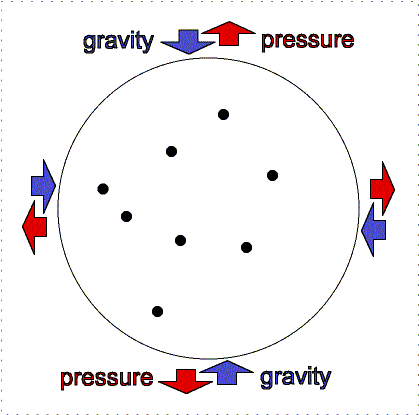
Hydrostatic
equilibrium: gravity compression is balanced by pressure outward. |
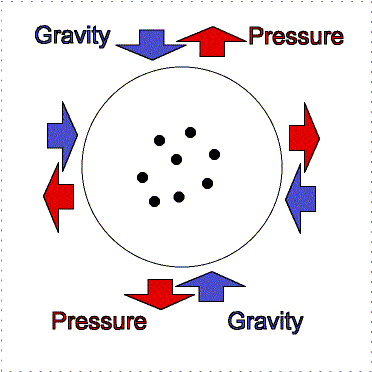
Greater gravity
compresses the gas, making it denser and hotter, so the outward pressure
increases. |
In any given layer of a star, there is a balance between the thermal
pressure (outward) and the weight of the material above pressing downward
(inward). This balance is called hydrostatic equilibrium. A star is like
a balloon. In a balloon the gas inside the balloon pushes outward and the
elastic material supplies just enough inward compression to balance the gas
pressure. In a star the star's internal gravity supplies the inward compression.
Gravity compresses the star into the most compact shape possible: a sphere.
Stars are round because gravity attracts everything in an object to the center.
Hydrostatic equilibrium also explains why the Earth's atmosphere does not
collapse to a very thin layer on the ground and how the tires on your car or
bicyle are able to support the weight of your vehicle.
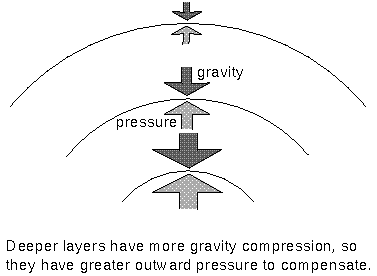
Long before astronomers knew about nuclear fusion, they had a good idea of
how the density and temperature of stars increased toward their cores. Deeper
layers have more gravity compression from the overlying layers. The
greater gravity compression raises the density of the gas. In order to balance
the greater gravity compression, the outward pressure of the gas and radiation
is increased by raising the temperature. Calculating the change in density and
temperature layer by layer toward the center of a star, you find the temperature
at the core of a star = 8 to 28 million K and the densities = 10 to 130 times
the density of water. As stars age, these numbers increase! You have already
seen in the previous
section that hydrostatic equilibrium also provides a ``thermostatic
control'' on the energy generation inside a star and keeps the star stable.
Other basic physical principles are put
into the mathematical models:
- Continuity of Mass: the total stellar mass =
sum of all of the shell layer masses. Mass is distributed smoothly throughout
star's interior (there are no gaps or pockets of ``negative'' mass). Also, the
law of the conservation of mass says that the total amount of mass does not
change with time.
- Continuity of Energy: the amount of energy
flowing out the top of each shell layer in a star = the amount of energy
flowing in at bottom of the shell layer. No energy is magically destroyed or
created from nothing. A star's luminosity = sum of all of the shell layer
energies. Also, the law of the conservation of energy says that the total
amount of energy does not change with time. Energy can change from one form to
another form of energy, but the total amount is a constant.
- Energy Transport: Recall from the discussion
about how
energy flows in planetary atmospheres that energy moves from hot to cold
via conduction, radiation, or convection. Nature will first try to use
radiation (photons) to move energy from the very hot interior to the very cold
space. If radiation cannot transport all of the energy over the distance from
the center to the surface of the star, then nature will also use convection.
Convection is the bulk motion of gases used to transport energy. Hot gases
rise to the upper levels and radiate their extra energy at the upper levels
while cooler gases sink to pick up more energy from the hot interior.
Conduction transports energy by having each atom transfer its energy to the
atom next to it. Conduction is not an efficient process in a gas so it
transports a very small amount of energy in stars and is usually ignored.
- Opacity: It takes a LONG time for photons
produced by nuclear reactions in the core to reach the surface. In the opaque
interior a photon travels only about 1 centimeter before it runs into an atom
or ion and is absorbed. A measure of the gas' ability to absorb the photons is
called its opacity. You cannot see into the interior of a star because
the gas has a high opacity.
The photon is later re-emitted but in a random direction. It may be
re-emitted in the direction it came from! So the photon travels a very zig-zag
sort of path outward. It takes about a million years for a photon to travel
from where it was created in the core to the surface where it is finally
released into space. Along the way the photon has transferred some its energy
to the gas particles, so the photon has changed from very high energy gamma
rays to the lower energy visible light photons. Some of the radiation is also
in the form of neutrinos. The gas has almost zero opacity with the neutrinos
so they pass right on through the star's gas in just a few seconds.
- The equation of state, hydrostatic equilibrium and the other physical
principles are put together for each layer in a star. The equations are solved
for each layer starting from the layer there is direct information of, the
surface. That result gives the conditions for the next layer's equations.
Solving the layer's equations gives the conditions for the layer below it and
this process continues on down toward the center layer by layer. In order to
get sufficient detail for accurate results, the star's interior is divided
into hundreds of layers. To save on time, the equations are solved using a
computer.
Observations of
thousands of main sequence stars show that there is definite relationship
between their mass and their luminosity. The more massive main sequence stars
are hotter and more luminous than the low-mass main sequence stars. Furthermore,
the luminosity depends on the mass raised to a power that is between three and
four (Luminosity ~ Massp, where p is between 3 &
4). This means that even a slight difference in the mass among stars produces a
large difference in their luminosities. For example, an O-type star can be only
20 times more massive than the Sun, but have a luminosity about 10,000 times as
much as the Sun. Putting together the principle of hydrostatic equilibrium and
the sensitivity of nuclear reaction rates to temperature, you can easily explain
why.
Massive stars have greater gravitational compression in their cores because
of the larger weight of the overlying layers than that found in low-mass stars.
The massive stars need greater thermal and radiation pressure pushing outward to
balance the greater gravitational compression. The greater thermal pressure is
provided by the higher temperatures in the massive star's core than those found
in low-mass stars. Massive stars need higher core temperatures to be
stable!
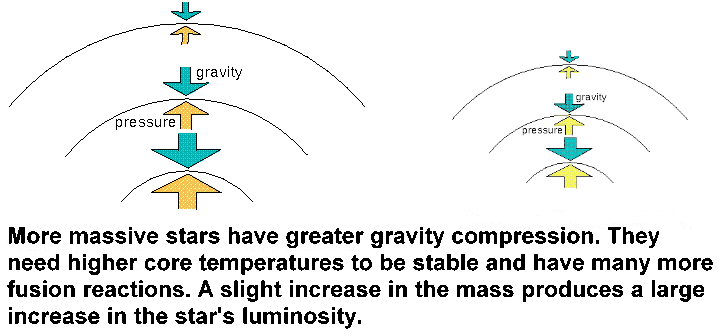
The nuclear reaction rate is very sensitive to temperature so that
even a slight increase in temperature makes the nuclear reactions occur at a
MUCH higher rate. This means that a star's luminosity increases a lot
if the temperature is higher. This also means that a slight increase in the mass
of the star produces a large increase in the star's luminosity.
The principle of hydrostatic
equilibrium and nuclear fusion theory also explain why stars have a certain
range of masses. The stars have masses between 0.08 and about 100 solar masses.
Stars with too little mass do not have enough gravitational compression in
their cores to produce the required high temperatures and densities needed for
fusion. The lowest mass is about 0.08 solar masses or about 80 Jupiter masses.
Stars less massive than this do not undergo fusion and are called brown
dwarfs. Selecting the brown dwarf link will take you to a site with
further information about brown dwarfs and the first one discovered called
Gliese 229B.
The boundary between brown dwarfs and big gas planets is fuzzy, though gas
planets are thought to form from solid cores accreting interplanetary nebula
material, and therefore, should have relatively more heavy elements than a
star/brown dwarf which forms from simple gravitational collapse of a gas cloud.
A rough boundary between the two is 20 Jupiter masses. The companion
orbiting the star Gliese 229 is at this boundary mass. Selecting the picture of
Gliese 229 and its companion will take you to the caption for the picture at the
Space Telescope Institute.
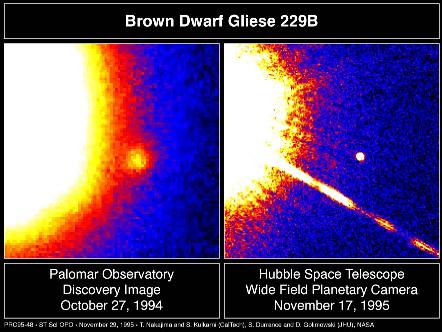
Stars with too much mass have so much radiation pressure inside pushing
outward on the upper layers, that the star is unstable. It blows off the excess
mass. The limit is about 100 solar masses. Stars like Eta Carinae and the ``Pistol
star'' are examples of these supermassive stars. The picture of Eta Carinae
below shows two dumbbell-shaped lobes of ejected material from the star in an
earlier episode of mass ejection. Selecting the image will take you to more
information about the image at the Space Telescope Institute.
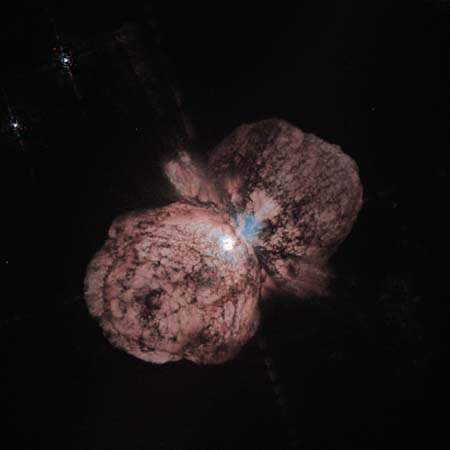
The picture below from the Hubble Space Telescope shows the violet Pistol
Star surrounded by hydrogen gas fluorescing from the copious ultraviolet light
coming from the star. Selecting the image will bring up the press release from
the Space Telescope Institute.
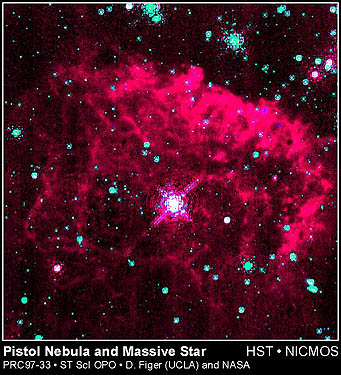
Vocabulary
| brown dwarfs |
equation of state |
hydrostatic equilibrium |
| ideal gas law |
mass density |
mathematical models |
| opacity |
pressure |
temperature |
- How can you determine what the interiors of stars are like?
- What three quantities does an equation of state relate?
- What is the equation of state for gases? (Almost any gas has this equation
of state, even the air in your automobile tires or air-filled ball.)
- Use the equation of state of a gas to explain in what way the temperature
of the gas changes as the pressure exerted on the gas is increased. Explain
why the pressure in your automobile tires is slightly less when they are cold
than right after a long drive.
- What is being equilibrated in hydrostatic equilibrium? How does
hydrostatic equilibrium explain why the temperature and density increases
inward toward the core of a star?
- How does hydrostatic equilibrium control the fusion rate in the Sun?
- What would happen to the size of a star if its core steadily
produced more energy than it did at some earlier time (e.g., when a main
sequence star becomes a red giant)?
- What would happen to the size of a star if its core steadily
produced less energy than it did at some earlier time (e.g., when a star stops
fusing nuclei in its core)?
- Do photons produced in the core zip right out from the Sun or does it take
longer? Explain why.
- Why do brown dwarfs not undergo fusion?
- What are some basic differences between stars and planets?
 Go
to Nuclear Fusion and Neutrino sections
Go
to Nuclear Fusion and Neutrino sections
last update: 07 April 1999
Is this page a copy of
Strobel's Astronomy Notes?
Author of original content:
Nick Strobel










![]() Go
to Nuclear Fusion and Neutrino sections
Go
to Nuclear Fusion and Neutrino sections